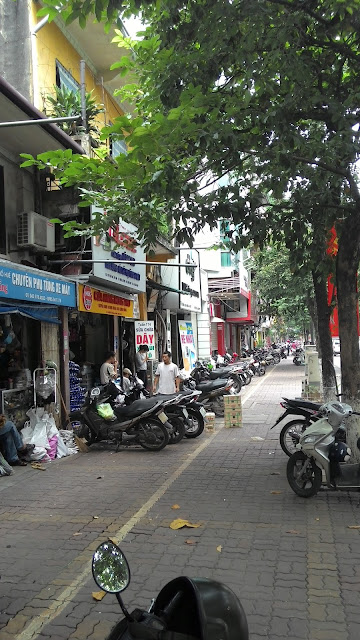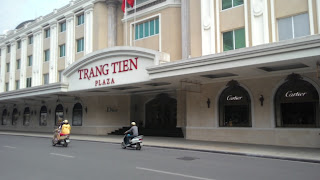 I came across this hydrant, judging by its
paint a fairly old one, and was amazed that it still had its cap (or maybe it's
a spigot). Jakarta hydrants do not have them anymore. Removed and taken to a
scrap-metal dealer. Even the nuts, used to bolt the struts together of the
Java-Madura bridge that were easily accessible from its roadway, were removed
within a few weeks after the bridge was officially opened.
I came across this hydrant, judging by its
paint a fairly old one, and was amazed that it still had its cap (or maybe it's
a spigot). Jakarta hydrants do not have them anymore. Removed and taken to a
scrap-metal dealer. Even the nuts, used to bolt the struts together of the
Java-Madura bridge that were easily accessible from its roadway, were removed
within a few weeks after the bridge was officially opened. 
It also struck me that the covers of the below-street-level
sewers or ducts, are made of concrete with a proper water to cement to
aggregates ratio, while the ones made of cast iron have not found their way to
a scrap metal dealer.
And such a delight to be able to walk on
well paved wide pavements, though parked cars and motorcycles often frustrate
one's passage.
Especially now during the cool autumn month of
October, walking the Hanoi roads is a real joy.
One of the most amazing things in Hanoi is the way
cables (electricity, telephone) are strung overhead. How can anybody know what
is connected to what. But it looks that on some main roads the old system is
being replaced by something neater; at least that's what I think the cables being
cut down means.
In respect of scrap metal dealers, I
suddenly remember the story of the railway tracks. It happened some 50 years
ago in Holland. In a pub that I frequented as a student, I had made the acquaintance
of a scrap metal dealer. He often stood me a beer and I listened to his
stories. One day he almost shouted: WTF
is happening to the world, I can't even trust my fellow dealers anymore… To
me that sounded overly naïve, or was it stupidity, that made him expect fair,
gentlemanly commercial practices where in fact there were none.
But anyway, this is what happened. He had
been told of surplus rail the national railway company had sold. And as the original
buyer suddenly needed quick money and was prepared to sell some of the rail at
a considerably reduced price, they were bought by my acquaintance.
While loading the rail at the site—along
the Rotterdam-Schiedam railway line—he was approached by a railway inspector
who inquired in a heated way what the fuck he thought he was doing. He couldn't
even complete his explanation before he was told that he had to immediately
unload again, as these rail were to be used for the construction of an
additional rail track. And whatever papers and contracts my man tried to show,
he was to unload double quick, or the police would be called.
My acquaintance had lost a considerable sum
of money, and the seller had left for an unknown destination shortly after
receiving the money. urprisingly, I was treated to a night-long drinking
spree plus a meal of fried chicken and chips.












